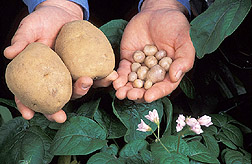This page has been archived and is being provided for reference purposes only. The page is no longer being updated, and therefore, links on the page may be invalid.
|
|
Revamping Relationships Among Cultivated Potatoes
By Ann PerryNovember 20, 2007
"One potato, two potato, three potato, four" turns out to be exactly right—when classifying cultivated potatoes, that is. Scientists at the Agricultural Research Service (ARS) and the International Potato Center (CIP) have used morphology—the outward appearance of a plant- -in combination with molecular markers to revise the number of potato species from seven to four.
Until recently, potato species designations have been based primarily on morphological characteristics and estimates—often incorrect—of how many chromosome sets they possessed.
Botanist David Spooner works in the ARS Vegetable Crops Research Unit, Madison, Wis. His initial research with CIP colleagues in Peru indicated that morphological variations among cultivated potatoes were not reliable indicators of species.
They then examined DNA molecular markers from 742 cultivated potato varieties and eight wild relatives of potatoes. Based on results from this study and previous studies, Spooner and CIP lead scientist Marc Ghislain concluded that cultivated potato varieties could most accurately be assigned to one of four species.
They refined the species designations by checking each potato variety for the presence of one particular DNA mutation. This characteristic mutation distinguishes between potatoes from the Chilean lowlands and potatoes from the high Andes.
Solanum tuberosum—the type of domesticated potato eaten around the world—is one of the four recognized species. This is by far the most common potato species and has from two to four sets of chromosomes.
The less common potato species—S. ajanhuiri, S. juzepczukii and S. curtilobum—have two, three and five sets of chromosomes, respectively. These can often be distinguished from each other by morphological data.
This new system of species classification eliminates much of the guesswork that previously served as the foundation for the potato classification system. Potato breeders will benefit greatly from a classification system that groups related collections by combining traditional morphological with modern molecular methods.
A paper reporting the results of this study was published this week in the Proceedings of the National Academy of Sciences of the United States of America.
ARS is the U.S. Department of Agriculture's chief scientific research agency.

